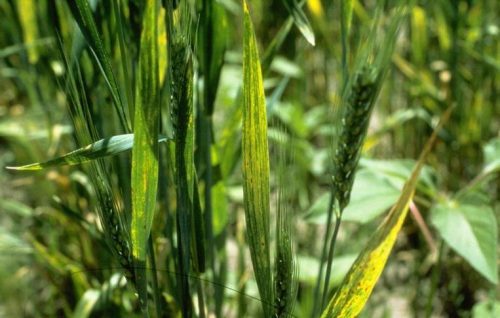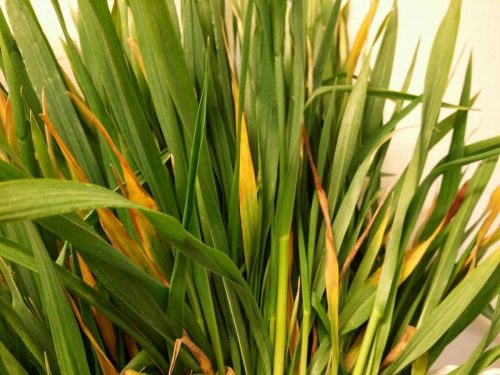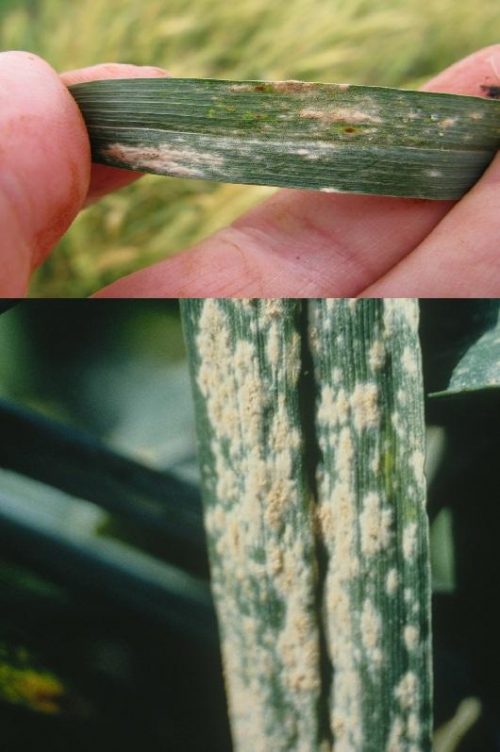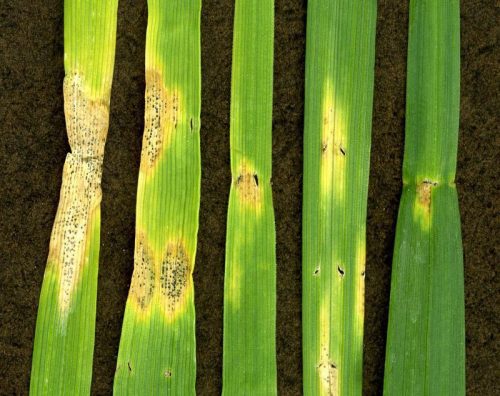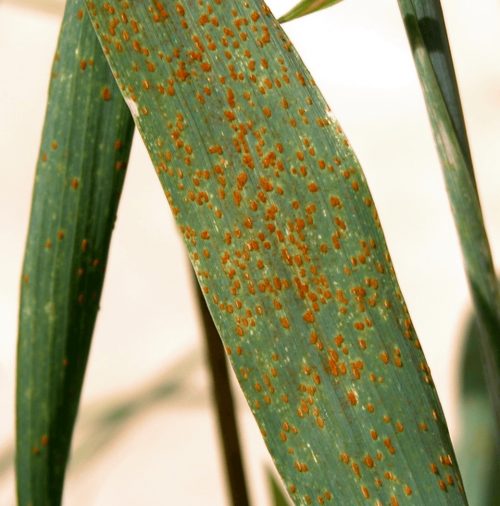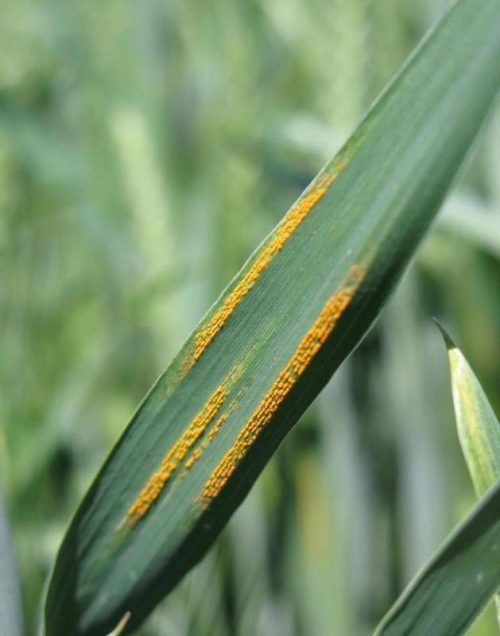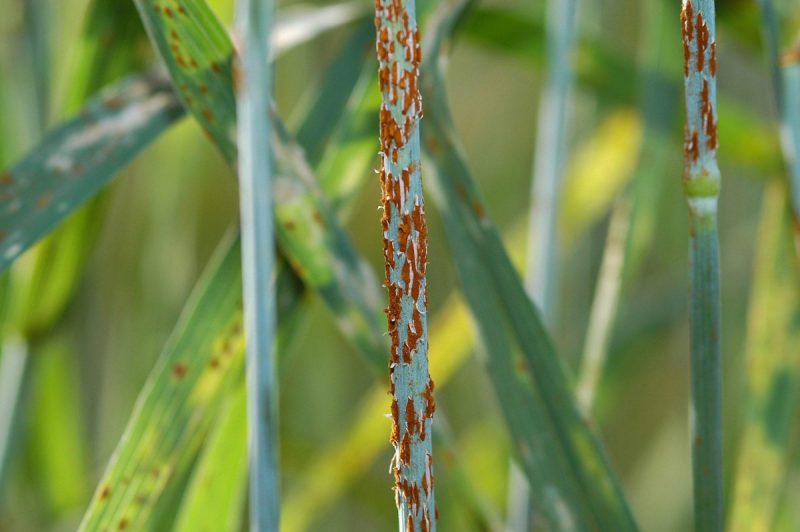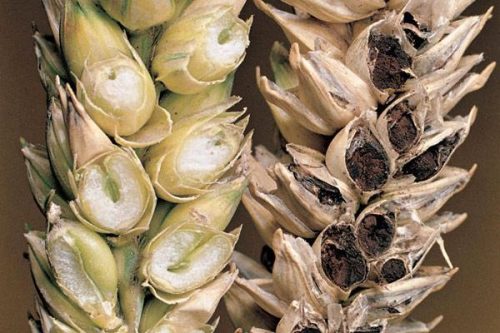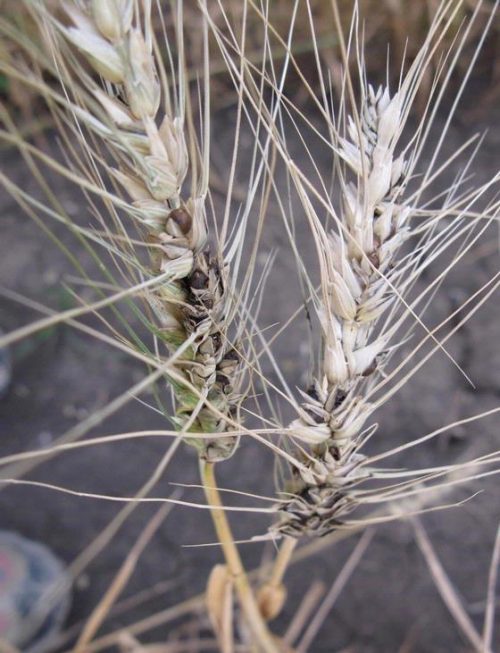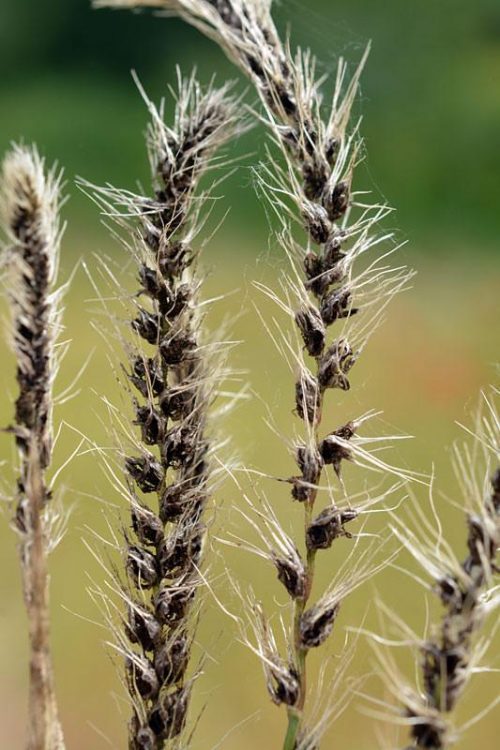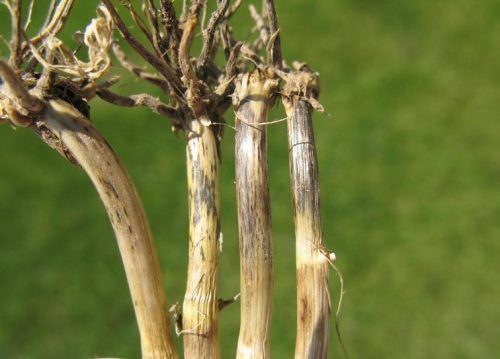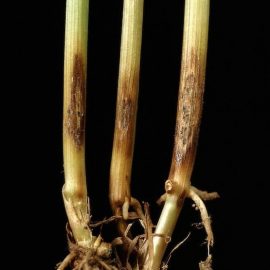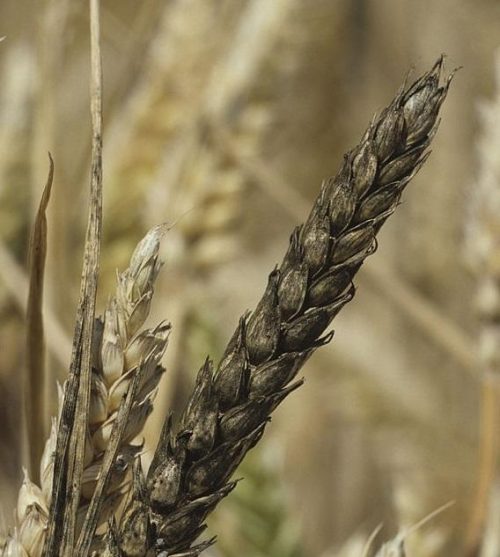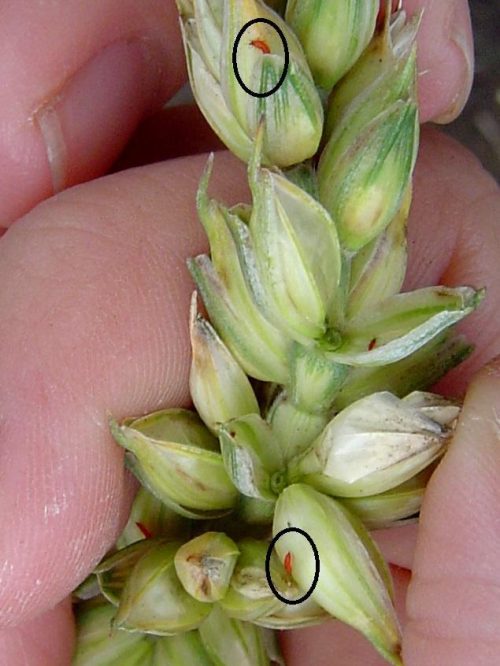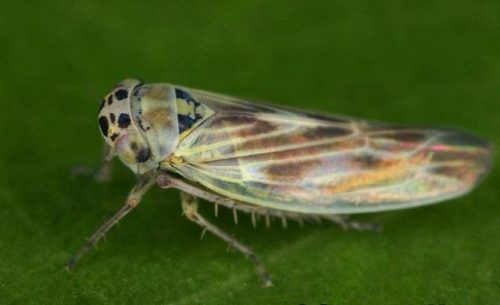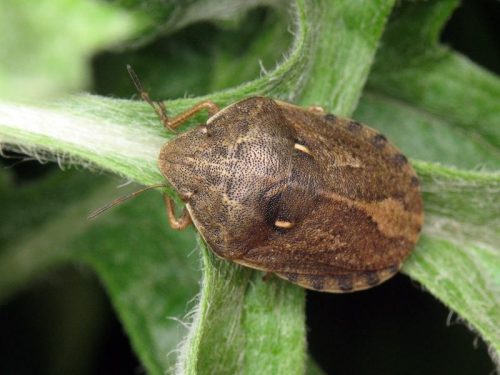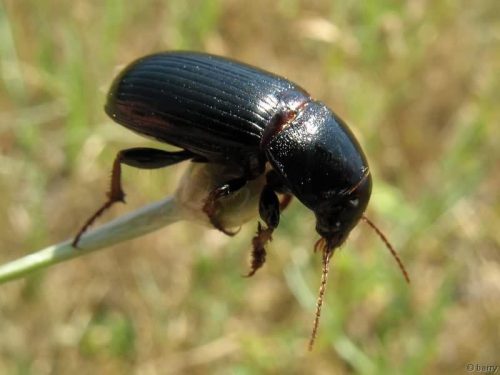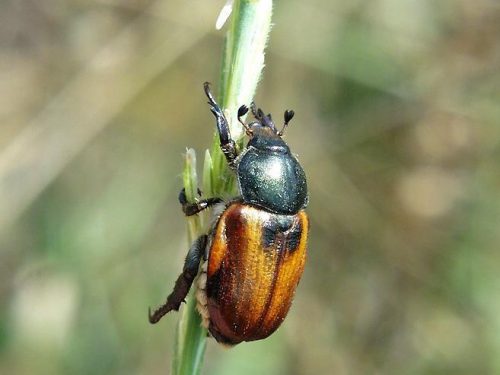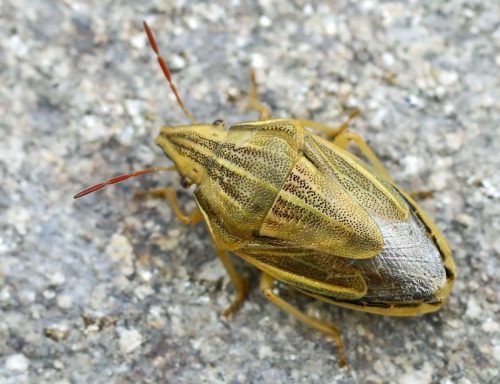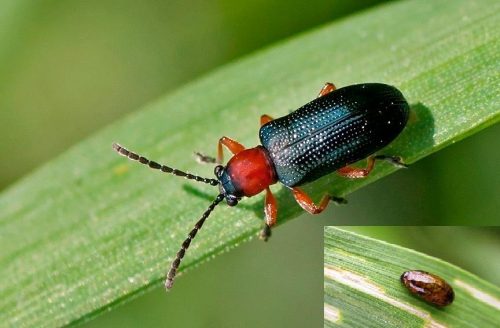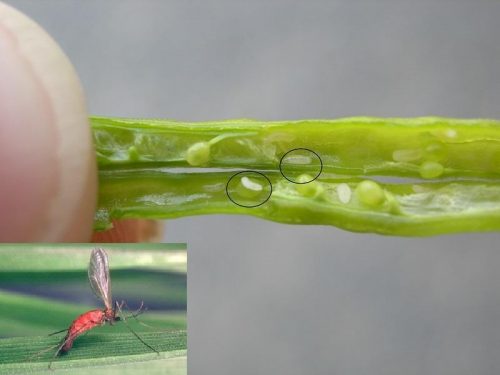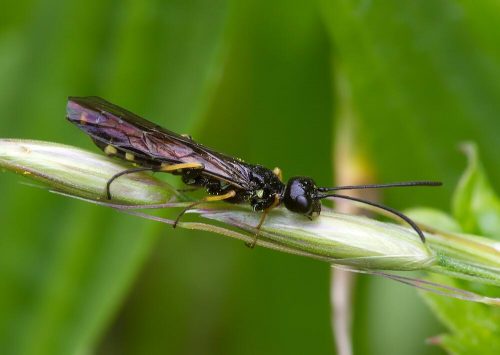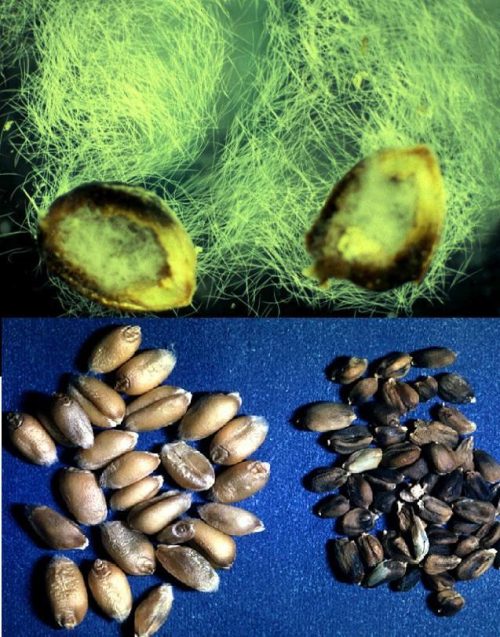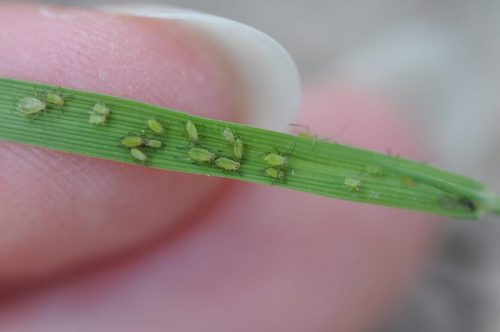Wheat treatments, pest and disease control
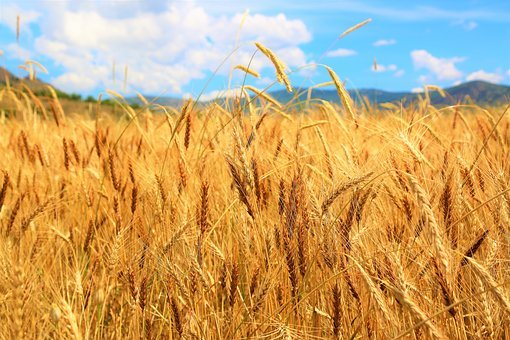
Wheat (Triticum aestivum) is the most cultivated plant in the world, being an important currency in the world economy. Wheat originated in Asia and was introduced as a cultivated crop several thousand years ago. It has gained popularity since the moment it was discovered and is a staple in the diet of many nationalities. Given the particular importance of this crop, knowing the diseases and pests that can negatively affect wheat production is very important.
The main diseases of wheat
Wheat streak mosaic virus
The first symptoms appear a few weeks after sprouting. Light green or yellow stripes appear on the leaves, parallel to the ribs. The symptoms of the disease are masked in autumn as the temperatures drop and reappear in spring. In case of a strong attack, the basal leaves turn yellow, and the ones at the top have a mosaic appearance. Infected wheat plants stagnate and produce poorly developed spikes. This virus attacks several species in the Poaceae family and is transmitted by mites.
Prevention and control measures:
- destroying the weeds in the crop;
- carrying out specific agrotechnical works;
- sowing at the optimum time;
- applying insecticides to control mites;
- cultivating resistant varieties.
Barley yellow dwarf virus
This virus aggressively attacks wheat crops. The attacked plants have a darker color and then turn yellow. The virus attacks the plants even in the seedling phase, dwarfing them. This is accompanied by the fact that the spikes no longer develop. If the plants are affected in the tillering phase, they germinate less, and the tips and ribs of the leaves become yellow. The attacked plants develop spikes, but with a large number of sterile spikelets. This virus is transmitted by aphids.
Prevention and control measures:
- destroying the weeds in the crop;
- carrying out specific field works;
- sowing at the optimum time;
- applying insecticides to control aphids;
- cultivating resistant varieties.
Powdery mildew (Erysiphe graminis)
The disease appears in spring. On the basal leaves and stems develop white, felt-like spots. The spots become dusty, and on them appear circular formations that represent the fructification of the fungus. The attack can spread quickly and can even attack the spikes. The attacked tissues turn yellow and dry out. The leaves dry out prematurely, the spikes do not grow normally, and the plant produces dry grains. The fungus overwinters on the plant remains from the surface of the soil. Wet autumn weather can cause autumn infections. The occurrence of the disease is favored by excessive fertilization with nitrogen, monoculture, or high density when sowing.
Prevention and control measures:
- burying plant remains through plowing;
- destroying the weeds;
- balanced fertilization;
- cultivating resistant wheat varieties;
- carrying out 1-2 treatments with specific fungicides in the phenophase of straw or spike development.
Recommended products
-
You can find products on a different store
Change Store -
You can find products on a different store
Change Store -
You can find products on a different store
Change Store -
You can find products on a different store
Change Store -
You can find products on a different store
Change Store -
You can find products on a different store
Change Store -
You can find products on a different store
Change Store -
You can find products on a different store
Change Store -
You can find products on a different store
Change Store -
You can find products on a different store
Change Store -
You can find products on a different store
Change Store -
You can find products on a different store
Change Store -
You can find products on a different store
Change Store -
You can find products on a different store
Change Store -
You can find products on a different store
Change Store -
You can find products on a different store
Change Store -
You can find products on a different store
Change Store -
You can find products on a different store
Change Store -
You can find products on a different store
Change Store -
You can find products on a different store
Change Store -
You can find products on a different store
Change Store -
You can find products on a different store
Change Store -
You can find products on a different store
Change Store -
You can find products on a different store
Change Store
Septoria leaf spot (Septoria tritici)
The main symptoms of this disease manifest on the leaves. The first symptoms appear on the tips of the leaves in the form of yellow spots, and over time they become gray. The disease evolves and in the middle of the spots, there are blackish punctiform formations, which represent the fructification of the fungus. The attacked leaves dry out prematurely, and the affected plants no longer grow normally. During the vegetative growth period, the fungus is transmitted through spores, and during winter the fungus overwinters on the affected plant remains. The occurrence of the disease is favored by excessive fertilization with nitrogen, monoculture, or high density when sowing.
Prevention and control measures:
- burying plant remains through plowing;
- destroying the weeds;
- a correct crop rotation;
- ensuring an optimal sowing density;
- carrying out treatments with specific fungicides.
Recommended products
-
You can find products on a different store
Change Store -
You can find products on a different store
Change Store -
You can find products on a different store
Change Store -
You can find products on a different store
Change Store -
You can find products on a different store
Change Store -
You can find products on a different store
Change Store -
You can find products on a different store
Change Store -
You can find products on a different store
Change Store -
You can find products on a different store
Change Store -
You can find products on a different store
Change Store -
You can find products on a different store
Change Store -
You can find products on a different store
Change Store -
You can find products on a different store
Change Store -
You can find products on a different store
Change Store -
You can find products on a different store
Change Store -
You can find products on a different store
Change Store -
You can find products on a different store
Change Store -
You can find products on a different store
Change Store -
You can find products on a different store
Change Store -
You can find products on a different store
Change Store -
You can find products on a different store
Change Store -
You can find products on a different store
Change Store -
You can find products on a different store
Change Store -
You can find products on a different store
Change Store
Wheat leaf rust (Puccinia recondita)
This disease occurs in early spring leading to the formation of oval, elliptical or circular, rusty formations called uredopustules. Later, the oval teleutopustules appear on the underside, black in color, which is covered by the epidermis of the leaf. After the epidermis ruptures, the formations become dusty, and the leaves turn yellow and dry out.
Prevention and control measures:
- cultivating resistant wheat varieties;
- sowing at the optimum time;
- balanced fertilization;
- carrying out treatments with specific fungicides.
Recommended products
-
You can find products on a different store
Change Store -
You can find products on a different store
Change Store -
You can find products on a different store
Change Store -
You can find products on a different store
Change Store -
You can find products on a different store
Change Store -
You can find products on a different store
Change Store -
You can find products on a different store
Change Store -
You can find products on a different store
Change Store -
You can find products on a different store
Change Store -
You can find products on a different store
Change Store -
You can find products on a different store
Change Store -
You can find products on a different store
Change Store -
You can find products on a different store
Change Store -
You can find products on a different store
Change Store -
You can find products on a different store
Change Store -
You can find products on a different store
Change Store -
You can find products on a different store
Change Store -
You can find products on a different store
Change Store -
You can find products on a different store
Change Store -
You can find products on a different store
Change Store -
You can find products on a different store
Change Store -
You can find products on a different store
Change Store -
You can find products on a different store
Change Store -
You can find products on a different store
Change Store
Stripe rust (Puccinia striiformis)
This fungus attacks all the aerial organs of the plant. Rectangular, orange pustules develop on the attacked organs, arranged in parallel rows. The infection starts from the basal leaves, and in severe cases, it can also attack the spikes. The attack results in premature drying of the leaves, a slowdown in the growth of the spikes, and the shriveling of the grains.
Prevention and control measures:
- cultivating resistant wheat varieties;
- sowing at the optimum time;
- balanced fertilization;
- products that control the wheat leaf rust can also be used against stripe rust.
Stem rust (Puccinia graminis)
The symptoms of the disease manifest through the appearance of formations called pustules, on all the aerial organs of the plant, especially on the stem. For this reason, it is also called straw rust. Unlike wheat leaf rust or stripe rust, in the case of stem rust, the attack starts from the top of the plant.
Prevention and control measures:
- cultivating resistant wheat varieties;
- sowing at the optimum time;
- balanced fertilization;
- products that control wheat leaf rust and stripe rust can also be used against stem rust.
Fusarium head blight (Gibberella zeae)
This disease appears in the years with hot and dry summers. The disease manifests from the seedling phase when brown spots appear on the stems of plants. Following the attack, the stems rot. When the fungus attacks in the tillering phase, the plants display browning at the base of the stems. They remain small and will form poorly developed brown spikes. The most serious attack manifests during the phase of spike development when the whitening and reddening of the spikes occurs. At the base of the whitened spikelets, a pink mold or orange pads develop, which represent the fructification of the mushroom. The grains are dry and lose their germinative capacity. The transmission of the disease during the vegetative growth period is ensured by the spores and mycelium of the fungus. From one year to the other the transmission is ensured by the infected seeds.
Prevention and control measures:
- balanced fertilization;
- avoiding monoculture or the wheat-corn rotation;
- cultivating resistant wheat varieties;
- treating the seeds before sowing;
- carrying out treatments with specific fungicides in the phase of inflorescence development.
Recommended products
-
You can find products on a different store
Change Store -
You can find products on a different store
Change Store -
You can find products on a different store
Change Store -
You can find products on a different store
Change Store -
You can find products on a different store
Change Store -
You can find products on a different store
Change Store -
You can find products on a different store
Change Store -
You can find products on a different store
Change Store -
You can find products on a different store
Change Store -
You can find products on a different store
Change Store -
You can find products on a different store
Change Store -
You can find products on a different store
Change Store -
You can find products on a different store
Change Store -
You can find products on a different store
Change Store -
You can find products on a different store
Change Store -
You can find products on a different store
Change Store -
You can find products on a different store
Change Store -
You can find products on a different store
Change Store -
You can find products on a different store
Change Store -
You can find products on a different store
Change Store -
You can find products on a different store
Change Store -
You can find products on a different store
Change Store -
You can find products on a different store
Change Store -
You can find products on a different store
Change Store
Karnal bunt of wheat (Tilletia sp.)
When the plants are attacked in the early stages of vegetative growth, they display stagnation, weak tillering, and a greenish-blue coloration. The spikes look messy, leaving the seeds exposed. The attacked grains are more convex, and their contents are replaced by a mass of black spores and the smell of spoiled fish. During harvesting, the attacked grains break, which leads to the release of the spores. Some of the spores remain on the ground and will produce new infections, while others adhere to the healthy seeds.
Prevention and control measures:
- deep summer plowing;
- sowing at the optimum time;
- a correct crop rotation;
- cleaning the combines when switching from one field to another;
- treating the seeds before sowing.
Recommended products
-
You can find products on a different store
Change Store -
You can find products on a different store
Change Store -
You can find products on a different store
Change Store -
You can find products on a different store
Change Store -
You can find products on a different store
Change Store -
You can find products on a different store
Change Store -
You can find products on a different store
Change Store -
You can find products on a different store
Change Store -
You can find products on a different store
Change Store -
You can find products on a different store
Change Store -
You can find products on a different store
Change Store -
You can find products on a different store
Change Store -
You can find products on a different store
Change Store -
You can find products on a different store
Change Store -
You can find products on a different store
Change Store -
You can find products on a different store
Change Store -
You can find products on a different store
Change Store -
You can find products on a different store
Change Store -
You can find products on a different store
Change Store -
You can find products on a different store
Change Store -
You can find products on a different store
Change Store -
You can find products on a different store
Change Store -
You can find products on a different store
Change Store -
You can find products on a different store
Change Store
Dwarf bunt of wheat (Tilletia controversa)
The disease is similar to the Karnal bunt of wheat. But in the case of this infection, the attacked plants display severe dwarfism. The attacked plants cannot be harvested and the grains fall to the ground. The fungal spores remain viable for 4-5 years.
Prevention and control measures:
- deep summer plowing;
- sowing at the optimum time;
- sowing at the optimum depth;
- a correct crop rotation;
- the treatments applied against the Karnal bunt of wheat are also effective in the case of the dwarf bunt of wheat.
Loose smut of wheat (Ustilago tritici)
This disease is common in wheat crops and can cause significant damage. The attacked plants are smaller, and the leaf covering the spike is discolored. The attacked plants form spikes before the healthy ones. The elements of the spike are destroyed and transformed into a dusty mass of black spores. Initially, the organs of the spike are covered by a silver membrane. Then, it breaks and the spores are released and taken by the wind. Only the central axis (the stalk) remains from the spike.
Prevention and control measures:
- treating the seeds before sowing is the main method of prevention and control.
Black stem rot (Gaeumannomyces graminis)
The attacked plants are easily recognizable by their yellow color. If the plants are uprooted, it can be seen that the root system is destroyed. The base of the stem is also covered with brown mycelium. The attacked tissues necrotize and the stem bends and breaks. After the attack, the plants dry out, the spikes fade, turn white, and no longer form grains.
Prevention and control measures:
- if the attack of this disease manifests in a field, wheat or other straw cereals can be recultivated to the same land after at least three years;
- destroying the weeds;
- proper plowing;
- avoiding damp soils;
- following the optimum density;
- balanced fertilization.
Eyespot (Pseudocercosporella herpotrichoides)
This disease causes significant damage in humid areas with moderate temperatures. The disease occurs in the fall. The fungus attacks the base of the stem. Elliptical, whitish, or yellow spots, bordered by a brown halo appear on the stem. In the center of the spots, the fructification of the fungus develops in the form of a black dot. Inside the straw, a gray felt develops that represents the mycelium of the fungus. The attacked plants break at the level of the spots. If they survive the attack, they form sterile spikes.
Prevention and control measures:
- adhering to a five-year crop rotation;
- avoiding acidic soils or excessive nitrogen fertilization;
- carrying out a proper plowing;
- in case of severe attack (over 25% of the plants are affected), specific fungicide treatments have to be carried out.
Black spot (Cladosporium herbarum)
This disease attacks all the aerial organs of the plant, but the attack is more marked on the spikes. Black mycelium clusters appear on the seeds and on the elements of the spike. The attacked grains are dry, and poor-quality flour is obtained from them.
Prevention and control measures:
- if the attack of this disease manifests in a field, wheat or other straw cereals can be recultivated to the same land after at least three years;
- destroying the weeds;
- proper plowing;
- avoiding damp soils;
- following the optimum density;
- balanced fertilization.
Yellow leaf spot (Pyrenophora tritici-repentis)
On the leaves at the base of the plant appear brown spots bordered by a brown-gray halo. The disease evolves, and in the center of the spots appears the fructification of the fungus, black-brown in color. The spots merge and occupy large areas of the leaf. The attacked tissues dry out, break, and the leaf shreds. The attacked plants form dry grains.
Prevention and control measures:
- respecting the optimum density;
- destroying the weeds;
- a correct crop rotation;
- balanced fertilization;
- carrying out treatments with specific fungicides.
Recommended products
-
You can find products on a different store
Change Store -
You can find products on a different store
Change Store -
You can find products on a different store
Change Store -
You can find products on a different store
Change Store -
You can find products on a different store
Change Store -
You can find products on a different store
Change Store -
You can find products on a different store
Change Store -
You can find products on a different store
Change Store -
You can find products on a different store
Change Store -
You can find products on a different store
Change Store -
You can find products on a different store
Change Store -
You can find products on a different store
Change Store -
You can find products on a different store
Change Store -
You can find products on a different store
Change Store -
You can find products on a different store
Change Store -
You can find products on a different store
Change Store -
You can find products on a different store
Change Store -
You can find products on a different store
Change Store -
You can find products on a different store
Change Store -
You can find products on a different store
Change Store -
You can find products on a different store
Change Store -
You can find products on a different store
Change Store -
You can find products on a different store
Change Store -
You can find products on a different store
Change Store
The main pests of wheat
Wheat thrips (Haplothrips tritici)
It produces one generation per year and overwinters in the larval stage on the plant remains from the surface of the soil. Adults and larvae sting and suck the intracellular fluid from the floral organs, stalk, and grains. After the attack, the flowers fall, and the spikes become whitish and sterile. If the grains are attacked in the milk stage, they become dry.
Prevention and control measures:
- sowing at the optimum time;
- a correct crop rotation;
- carrying out the autumn plowing;
- applying treatments when there are more than 8 adult insects on a plant.
Recommended products
-
You can find products on a different store
Change Store -
You can find products on a different store
Change Store -
You can find products on a different store
Change Store -
You can find products on a different store
Change Store -
You can find products on a different store
Change Store -
You can find products on a different store
Change Store -
You can find products on a different store
Change Store -
You can find products on a different store
Change Store -
You can find products on a different store
Change Store -
You can find products on a different store
Change Store -
You can find products on a different store
Change Store -
You can find products on a different store
Change Store -
You can find products on a different store
Change Store -
You can find products on a different store
Change Store -
You can find products on a different store
Change Store -
You can find products on a different store
Change Store -
You can find products on a different store
Change Store -
You can find products on a different store
Change Store -
You can find products on a different store
Change Store -
You can find products on a different store
Change Store -
You can find products on a different store
Change Store -
You can find products on a different store
Change Store -
You can find products on a different store
Change Store -
You can find products on a different store
Change Store
Macrosteles sexnotatus
It produces 2-3 generations per year, it overwinters in the adult stage and sometimes in the egg stage. It attacks wheat, barley, rye, oats, corn, rice, etc. It stings the leaves and feeds on the intracellular fluid. The attacked tissues discolor and turn white. In case of a severe attack, the attacked tissues turn yellow and dry out.
Prevention and control measures:
- destroying the weeds;
- sowing at the optimum time;
- carrying out treatments with specific insecticides.
Sunn pest (Eurygaster sp.)
It produces one generation a year and overwinters in the adult stage in the foliage of forests or in other places sheltered from the weather. Adults appear in spring when temperatures exceed 9° C. After copulation, they lay their eggs on the plant’s aerial organs. The adults and larvae feed on the intracellular fluid of leaves, stems, spikes, and grains of wheat. When the attack takes place on the spike, the part above the sting turns white and no longer forms grains. The grains attacked in the milk-wax phase shrivel up.
Prevention and control measures:
- carrying out treatments with specific insecticides.
Recommended products
-
You can find products on a different store
Change Store -
You can find products on a different store
Change Store -
You can find products on a different store
Change Store -
You can find products on a different store
Change Store -
You can find products on a different store
Change Store -
You can find products on a different store
Change Store -
You can find products on a different store
Change Store -
You can find products on a different store
Change Store -
You can find products on a different store
Change Store -
You can find products on a different store
Change Store -
You can find products on a different store
Change Store -
You can find products on a different store
Change Store -
You can find products on a different store
Change Store -
You can find products on a different store
Change Store -
You can find products on a different store
Change Store -
You can find products on a different store
Change Store -
You can find products on a different store
Change Store -
You can find products on a different store
Change Store -
You can find products on a different store
Change Store -
You can find products on a different store
Change Store -
You can find products on a different store
Change Store -
You can find products on a different store
Change Store -
You can find products on a different store
Change Store -
You can find products on a different store
Change Store
Cereal ground beetle (Zabrus tenebrioides)
It produces one generation a year and overwinters in the larval stage in the soil. It resumes its activity immediately after the snow melts. Adults feed on the flowers and grains in different stages of ripening. The larvae feed only on the aerial parts of the plants, never on the roots. They attack the leaves, pull them inside the galleries dug in the soil, and tear them apart. The attacked plants are completely destroyed.
Prevention and control measures:
- carrying out treatments with specific insecticides.
Shining leaf chafer (Anisoplia sp.)
It produces a generation once every two years and overwinters in the larval stage. The adults of these species feed on the ovaries of the flowers and the grains in the milk or dough ripeness stage. Following the attack, the grains are partially or completely destroyed. The larvae are not harmful.
Prevention and control measures:
- plowing after harvesting the crop;
- a correct crop rotation;
- carrying out treatments when there are more than five adult insects per square meter.
Bishop’s Mitre (Aelia sp.)
It produces one generation a year and overwinters in the adult stage in the foliage of forests or in other places sheltered from the weather. Adults appear in spring and lay their eggs on the plant’s aerial organs. The adults and larvae feed on the intracellular fluid of leaves, stems, spikes, and grains. When the attack takes place on the spike, the part above the sting turns white and no longer develops grains. The grains attacked in the milk-wax phase shrivel up.
Prevention and control measures:
- carrying out treatments with specific insecticides.
Recommended products
-
You can find products on a different store
Change Store -
You can find products on a different store
Change Store -
You can find products on a different store
Change Store -
You can find products on a different store
Change Store -
You can find products on a different store
Change Store -
You can find products on a different store
Change Store -
You can find products on a different store
Change Store -
You can find products on a different store
Change Store -
You can find products on a different store
Change Store -
You can find products on a different store
Change Store -
You can find products on a different store
Change Store -
You can find products on a different store
Change Store -
You can find products on a different store
Change Store -
You can find products on a different store
Change Store -
You can find products on a different store
Change Store -
You can find products on a different store
Change Store -
You can find products on a different store
Change Store -
You can find products on a different store
Change Store -
You can find products on a different store
Change Store -
You can find products on a different store
Change Store -
You can find products on a different store
Change Store -
You can find products on a different store
Change Store -
You can find products on a different store
Change Store -
You can find products on a different store
Change Store
Oat leaf beetle (Lema melanopa)
It produces one generation a year and overwinters in the adult stage in the foliage of roadside grasses, hedges, forests, etc. Adults usually appear in the second decade of April and lay eggs on the topside of the leaves, close to the base, parallel to the main rib. The adults gnaw the leaves, piercing both the epidermis and the parenchyma, while the larvae consume the upper epidermis and parenchyma, leaving the lower epidermis intact. In case of a strong attack, the whole foliage acquires the appearance of transparent membranes.
Prevention and control measures:
- carrying out treatments if there are 10 adults or 250 larvae per square meter.
Recommended products
-
You can find products on a different store
Change Store -
You can find products on a different store
Change Store -
You can find products on a different store
Change Store -
You can find products on a different store
Change Store -
You can find products on a different store
Change Store -
You can find products on a different store
Change Store -
You can find products on a different store
Change Store -
You can find products on a different store
Change Store -
You can find products on a different store
Change Store -
You can find products on a different store
Change Store -
You can find products on a different store
Change Store -
You can find products on a different store
Change Store -
You can find products on a different store
Change Store -
You can find products on a different store
Change Store -
You can find products on a different store
Change Store -
You can find products on a different store
Change Store -
You can find products on a different store
Change Store -
You can find products on a different store
Change Store -
You can find products on a different store
Change Store -
You can find products on a different store
Change Store -
You can find products on a different store
Change Store -
You can find products on a different store
Change Store -
You can find products on a different store
Change Store -
You can find products on a different store
Change Store
Saddle gall midge (Haplodiplosis marginata)
It produces one generation per year and overwinters in the larval stage in the soil. From the end of April – the beginning of May, the larvae come to the surface of the soil and pupate. Adults appear after 4-5 days and lay their eggs on the foliar limb of the top leaves. The eggs and larvae are sensitive to dryness. After hatching, the larvae penetrate under the sheath of the leaves where they remain attached. The attacked plants have the sheath of the leaf swollen at the place where the larvae are. Elongated swellings with a strongly deepened middle where the larvae feed can also be observed. In the attacked areas, the straw has the fluid-conducting tissues destroyed. This slows down the growth and spike development, leading to premature ripening, and reducing the number of grains in the spike.
Prevention and control measures:
- carrying out treatments with specific insecticides if there are more than 5-6 larvae on a plant.
European wheat stem sawfly (Cephus pygmaeus)
It produces one generation per year and overwinters in the larval stage in the plant remains from the surface of the soil. The adults appear between May and June and lay their eggs near the internode under the spike. After hatching, the larva gnaws the contents of the straw. The spikes no longer grow and turn yellow. Precipitation and wind can cause the straw to break and the spikes to fall.
Prevention and control measures:
- deep plowing;
- a correct crop rotation;
- carrying out treatments with specific insecticides.
Recommended products
-
You can find products on a different store
Change Store -
You can find products on a different store
Change Store -
You can find products on a different store
Change Store -
You can find products on a different store
Change Store -
You can find products on a different store
Change Store -
You can find products on a different store
Change Store -
You can find products on a different store
Change Store -
You can find products on a different store
Change Store -
You can find products on a different store
Change Store -
You can find products on a different store
Change Store -
You can find products on a different store
Change Store -
You can find products on a different store
Change Store -
You can find products on a different store
Change Store -
You can find products on a different store
Change Store -
You can find products on a different store
Change Store -
You can find products on a different store
Change Store -
You can find products on a different store
Change Store -
You can find products on a different store
Change Store -
You can find products on a different store
Change Store -
You can find products on a different store
Change Store -
You can find products on a different store
Change Store -
You can find products on a different store
Change Store -
You can find products on a different store
Change Store -
You can find products on a different store
Change Store
Ear-cockle (Anguina tritici)
It produces one generation per year and overwinters in the larval stage in infested grains. In contact with moisture, the larvae come out and spread in search of young wheat plants. The attacked plants can be recognized by their small size, strong tillering, and thickening of the base of the stem. The leaves are dark green, twisted and crimpy. Following the attack, the grains are transformed into rounded galls and have a blackish-brown color.
Prevention and control measures:
- straw cereals can be recultivated to the same field after 3-4 years;
- applying fertilizers to increase plant resistance;
- cultivating resistant wheat varieties;
- using certified and conditioned seeds.
Wheat aphid (Schizaphis graminum)
It produces 15-20 generations per year and overwinters in the egg stage on wheat or on spontaneous species. The adults and larvae colonize the leaves and stems, where they suck the fluid from the tissues. The attacked leaves have red spots, curl up, and then dry. The strong attacks in autumn determine the drying of the plants, and during the grain development, it determines the decrease in production.
Prevention and control measures:
- sowing at the optimum time is recommended;
- destroying weeds;
- carrying out treatments when there are more than 10 insects on a plant.
Recommended products
-
You can find products on a different store
Change Store -
You can find products on a different store
Change Store -
You can find products on a different store
Change Store -
You can find products on a different store
Change Store -
You can find products on a different store
Change Store -
You can find products on a different store
Change Store -
You can find products on a different store
Change Store -
You can find products on a different store
Change Store -
You can find products on a different store
Change Store -
You can find products on a different store
Change Store -
You can find products on a different store
Change Store -
You can find products on a different store
Change Store -
You can find products on a different store
Change Store -
You can find products on a different store
Change Store -
You can find products on a different store
Change Store -
You can find products on a different store
Change Store -
You can find products on a different store
Change Store -
You can find products on a different store
Change Store -
You can find products on a different store
Change Store -
You can find products on a different store
Change Store -
You can find products on a different store
Change Store -
You can find products on a different store
Change Store -
You can find products on a different store
Change Store -
You can find products on a different store
Change Store














































































































































































































































































































































































































































